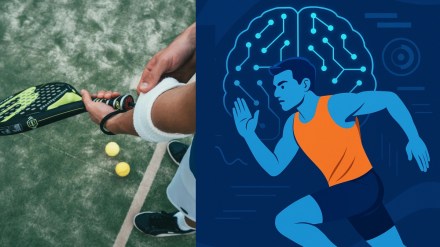By Shitiz Ruhail
Artificial Intelligence is no longer a futuristic concept in sports—it’s already redefining how athletes train, recover, and perform. The game-changer isn’t in replacing human expertise, but in amplifying it. Coaches, physiotherapists, and performance analysts now have AI-powered teammates enabling them to deliver precision, personalisation, and progress at scale. This is not disruption for the sake of disruption—it’s data-backed evolution.
Real-Time Intelligence on the Training Ground
Modern training isn’t about how long an athlete trains, but how intelligently. Wearable sensors and motion analysis tools now capture thousands of data points per session—from acceleration and posture to micro-changes in recovery. AI turns this raw data into actionable insights instantly.
Imagine a sprint coach adjusting an athlete’s gait mid-rep, or a strength coach identifying an asymmetry before it turns into a strain. These subtle yet critical interventions are happening in real time. And it’s this layer of data-assisted coaching that’s reducing injury risk, improving efficiency, and extending careers.
At the Sports Authority of India (SAI), this future is already reality. Through Speeed.AI, India’s only PDP-compliant 360° Athlete Management System, SAI has deployed AI-assisted training across national centers, touching the lives of about 4,000 elite athletes and staff across 25 sports. Coaches use it daily to generate personalized strength and conditioning plans, flag injury risks, and monitor real-time progress. In fact, the system’s injury prediction models alone have helped SAI reduce injury incidence, while simultaneously enhancing athlete recovery timelines.
Personalized Pathways, Not One-Size-Fits-All Programs
The era of standard routines is over. AI is enabling hyper-personalised training plans for young athletes based on their current fitness levels, biomechanical patterns, and training response. A 14-year-old working on agility no longer follows the same drill as a peer working on endurance.
This personalization is what keeps athletes engaged—and what ensures that talent across India’s towns and villages isn’t overlooked. Even a basic smartphone camera on a school field can now power movement assessments and flag promising athletes using AI models benchmarked to elite data.
Data-Driven Injury Prevention and Rehabilitation
Injury management is moving from reactive to predictive. AI models now identify early indicators of fatigue, overuse, and risk by tracking jump height trends, asymmetry in movements, or delayed reaction times. When the system spots a deviation, it prompts lighter sessions—preventing injuries before they happen.
Post-injury, AI plays an equally vital role. Remote rehabilitation via computer vision tools helps monitor form, track progress, and guide recovery protocols without needing in-person visits. The result: faster healing, better adherence, and a measurable drop in reinjury rates.
Elite Preparation with Precision Tools
For national teams and professional clubs, AI unlocks a new dimension of competitive advantage. Training programs are tailored daily, using insights from sleep, hydration, stress levels, and past performance. Game simulations are run with opponent-specific data—helping players mentally rehearse real match-day scenarios.
The athlete’s time is optimized, not stretched. Instead of doing more, they’re doing better—with sharper focus, quicker feedback, and reduced performance waste.
Mental Readiness with Objective Signals
Beyond the physical, AI is bringing structure to the mental game. Today’s platforms monitor stress, sleep consistency, and emotional balance—providing early alerts without judgment. For setups without in-house psychologists, this layer of insight is priceless.
It’s not therapy—it’s early warning. And when mental wellbeing is supported proactively, athletes show up sharper, calmer, and more consistent.
Smarter Coaching, Clearer Management
Gone are the days of endless video review. AI now auto-generates highlight reels, tags mistakes, and suggests tactical combinations based on past matches. Coaches spend less time combing through footage and more time coaching.
On the management side, athlete availability, health records, and performance metrics are merged into unified dashboards. From planning substitutions to managing minutes, decisions are informed, not instinctive.
Leveling the Playing Field—Literally
What was once accessible only to elite setups is now being democratized. Community coaches, government programs, and rural academies can access AI tools with basic hardware and cloud support. Talent is being spotted earlier. Feedback is structured. Burnout is flagged before it escalates.
Even parents become part of the ecosystem—with real-time visibility into their child’s progress, wellbeing, and potential.
The Bottom Line
Athletes are still at the center. But now, they’re backed by systems that see more, learn faster, and act smarter. The future of athlete development isn’t about more training. It’s about the right training, at the right time, powered by the right insights.
The author is co-founder and head of growth & strategy of Digital Darwin.
Disclaimer: Views expressed are personal and do not reflect the official position or policy of FinancialExpress.com. Reproducing this content without permission is prohibited.
